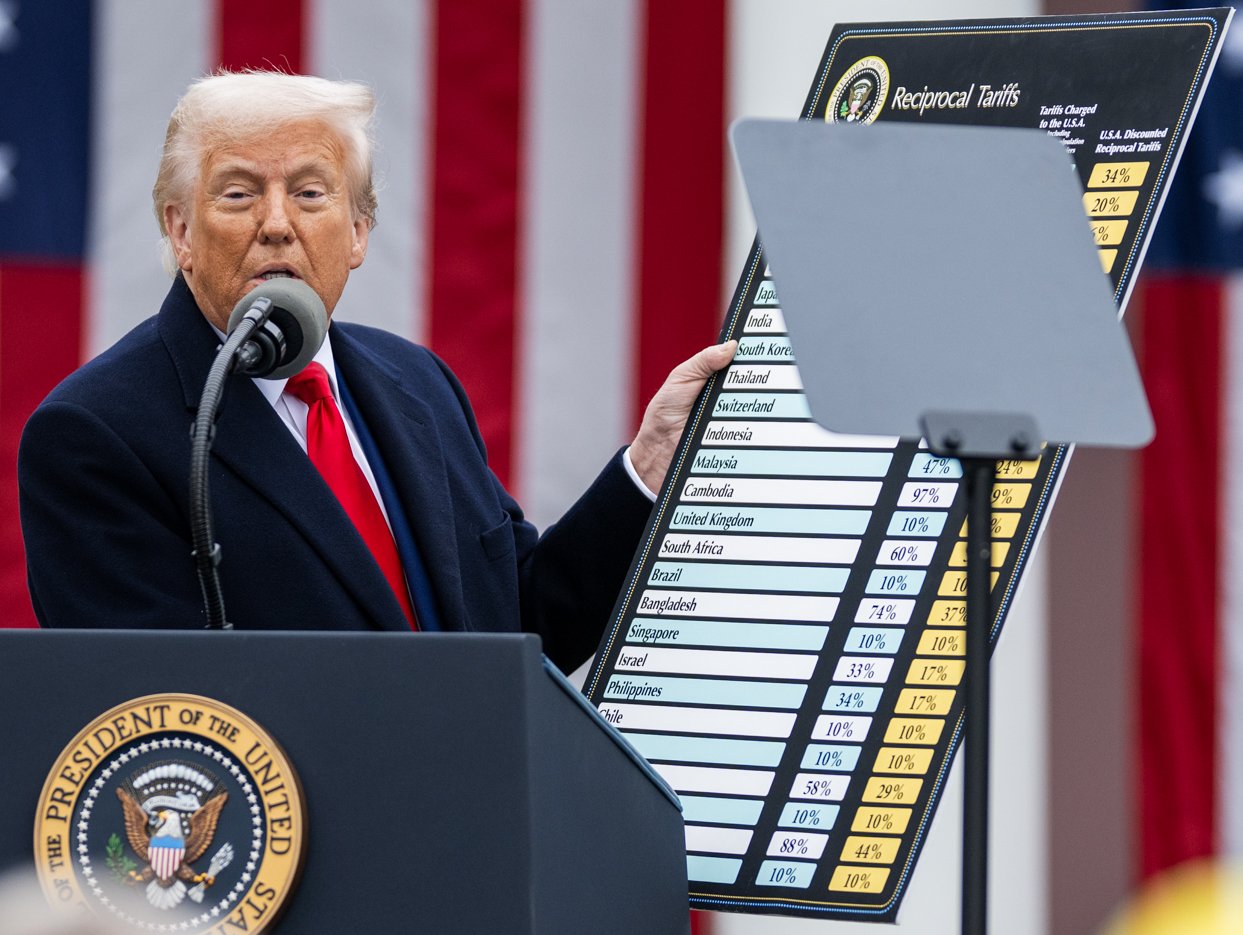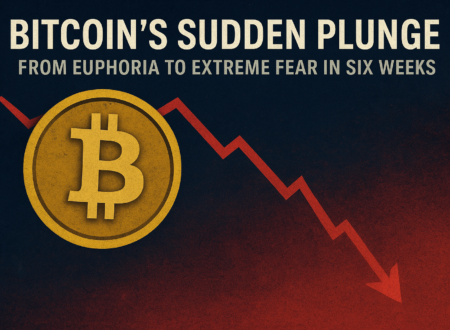Trump’s April 2025 Import Tariffs: A Catalyst for the Stock Market Crash?
On April 2, 2025, President Donald J. Trump stood in the White House Rose Garden, flanked by Commerce Secretary Howard Lutnick, to unveil what he dubbed “Liberation Day”, a sweeping set of import tariffs aimed at reshaping global trade and bolstering American manufacturing. The announcement introduced a baseline 10% tariff on all U.S. imports effective April 5, 2025, with additional, higher reciprocal tariffs targeting 57 countries, including steep levies of 34% on China, 20% on the European Union, and 46% on Vietnam, set to begin April 9, 2025. Trump’s stated goal was to address persistent trade deficits and protect U.S. sovereignty, invoking the International Emergency Economic Powers Act (IEEPA) of 1977. However, within days, this bold economic gambit triggered a seismic reaction: a stock market plunge that wiped out trillions in value, raising fears of a global recession.
This article delves into the specifics of Trump’s April 2025 tariffs, their immediate and projected economic impacts, and their role in precipitating what many now call the “Trump Tariff Crash.” Through detailed analysis, expert insights, and illustrative data, we explore how this policy shift has roiled financial markets and what it means for the future.
The Tariff Blueprint: Liberation Day Unveiled
Trump’s tariff plan, formalized on April 2, 2025, via an executive order, marked a dramatic escalation from his first-term trade policies. The baseline 10% tariff applied universally to all imports, while “reciprocal” tariffs, calculated as half the trade deficit divided by a country’s exports to the U.S., targeted nations with significant imbalances. For example, China faced a 34% tariff, reflecting its $375 billion trade surplus with the U.S. in 2024, while Canada and Mexico saw 25% tariffs tied to border security and fentanyl concerns.
The White House framed these measures as a response to decades of “unfair trade practices,” citing currency manipulation, value-added taxes (VAT), and suppressed domestic consumption in countries like China and Germany. Trump promised that the tariffs would generate $1.5 trillion in revenue over a decade, fund tax cuts, and spur a manufacturing renaissance. “We’re taking back our wealth and respect,” he declared, waving a chart of trade deficits.
Yet, the announcement blindsided markets. Unlike the targeted tariffs of 2018-2019, which focused on China and specific sectors like steel, this blanket approach hit allies and adversaries alike. The closure of the “de minimis” loophole, previously allowing low-value imports under $800 to bypass duties, further tightened the screws, impacting e-commerce giants like Amazon and Shein.
The Market’s Immediate Reaction: A Freefall Begins
The financial fallout was swift and severe. On April 3, 2025, the day after the announcement, U.S. stock futures plummeted, with Dow Jones Industrial Average futures dropping 1,200 points in premarket trading. When markets opened, the carnage intensified: the S&P 500 fell 4.84%, the Dow shed 1,679 points (3.98%), and the Nasdaq plunged 5.97%, its worst single-day drop since 2020. Globally, Europe’s STOXX 600 tumbled 2.57%, Japan’s Nikkei 225 declined 2.8%, and Asian markets followed suit.
By April 5, as the 10% baseline tariff took effect, the sell-off deepened. The S&P 500 shed nearly 6%, capping its worst week since the COVID-19 crash of 2020. The total loss in U.S. market value over two days exceeded $6 trillion, according to estimates from The Wall Street Journal. Companies with international supply chains, like Apple (down 9.3%), Nike (down 14.4%), and Best Buy (down 17.8%), bore the brunt, as investors feared higher costs and disrupted trade flows.

Why the Crash Happened: Unpacking the Economic Shockwaves
Several factors converged to drive this market collapse:
- Uncertainty Over Supply Chains: The broad scope of the tariffs caught businesses off-guard. Multinational firms reliant on imports, think Apple assembling iPhones in China or automakers sourcing parts from Mexico, faced immediate cost hikes. Delta Air Lines slashed its Q1 profit forecast by half on April 3, citing “economic uncertainty,” sending its stock down 14%.
- Retaliatory Fears: Trading partners didn’t sit idly by. China imposed a 34% counter-tariff on U.S. goods on April 4, targeting agriculture (soybeans, wheat) and minerals critical to tech manufacturing. Canada announced a 25% tariff on non-USMCA-compliant U.S. vehicles, while the EU prepared countermeasures against iconic American exports like Harley-Davidson motorcycles and orange juice. This tit-for-tat escalation fueled recession fears.
- Inflation Expectations: Economists, including those at the Tax Foundation, estimated that the tariffs would raise U.S. consumer prices by 2% annually, adding $2,100 to the average household’s costs in 2025. JPMorgan warned of a $660 billion tax hike equivalent, the largest since 1968. As Treasury yields dropped to 4.05%, a sign of investors fleeing to safe-haven bonds, the market priced in stagflation risks.
- Investor Panic: Hedge funds dumped over $40 billion in stocks post-announcement, per Reuters, amplifying the sell-off. The Cboe Volatility Index (VIX), Wall Street’s “fear gauge,” surged 39.6% on April 3, reflecting heightened panic.
Trump dismissed the turmoil, posting on Truth Social, “Hang tough. We can’t lose.” But analysts like Mona Mahajan of Edward Jones noted, “The size and scope exceeded even the most bearish forecasts,” underscoring the market’s unpreparedness.
Economic Projections: A Rocky Road Ahead
The tariffs’ long-term impact remains uncertain, but early forecasts paint a grim picture. The Tax Foundation predicts a 0.7% reduction in U.S. GDP over a decade, with imports dropping $900 billion in 2025 alone as consumers shift to pricier domestic goods or forego purchases. Retaliatory tariffs from China, Canada, and the EU, already affecting $330 billion in U.S. exports, could shave another 0.1% off GDP.
EY Chief Economist Gregory Daco warned of stagflation, modeling a 1% GDP drag in 2025 and a 1% rise in consumer price inflation by Q4. “A significant adverse financial market reaction could push the U.S. into recession,” he added. JPMorgan raised its global recession odds to 60%, up from 40%, citing a potential two-point growth hit.
Consumer sentiment, already wobbly at 64.7 in February (per the University of Michigan), likely worsened as price hikes loomed for everyday goods like avocados (90% from Mexico) and electronics. Retailers like Target and Best Buy signaled imminent increases, while Walmart vowed to “keep prices low”, a promise economists doubt can hold.
Global Ripples: A Trade War Spiral?
The tariffs didn’t just shake the U.S., they sent shockwaves worldwide. Europe’s luxury sector, from LVMH to Burberry, saw shares drop 3-9% as the 20% EU tariff threatened exports like French cognac and Italian wine. Japan’s auto industry, hit with a 24% levy, faced a gloomy outlook, with Prime Minister Shigeru Ishiba planning a U.S. visit to negotiate relief.
China’s retaliation escalated tensions, curbing U.S. access to rare earth minerals vital for tech and defense. Smaller economies, like the Falkland Islands (facing a 42% tariff on toothfish exports), voiced alarm over job losses. Oxford Economics warned that global growth could sink to its lowest since 2008, barring the COVID era, if the trade war intensifies.
French President Emmanuel Macron called the tariffs “brutal and unfounded,” urging EU unity, while Germany’s Olaf Scholz deemed them “fundamentally wrong.” Trump, unfazed, told reporters on Air Force One, “Every country has called us. We’re in the driver’s seat now.”
Trump’s Defiance vs. Market Reality
Despite the chaos, Trump and his team doubled down. Commerce Secretary Lutnick insisted on CNN, “This is the reordering of global trade. The president won’t back off.” Vice President JD Vance, on Fox News, framed the tariffs as part of a broader pro-worker agenda, conceding short-term pain: “We’re not going to fix things overnight.”
Yet, cracks appeared. Former Treasury Secretary Steve Mnuchin expressed hope that reciprocal tariffs could be “negotiated down,” while Elon Musk, a Trump advisor, advocated for a U.S.-Europe “zero-tariff zone”, a suggestion at odds with the current policy.
On April 5, as markets bled, Trump told reporters, “Sometimes you have to take medicine to fix something,” denying intent to tank stocks. White House Press Secretary Karoline Leavitt echoed, “Trust in President Trump. This is his proven formula.” But with the Nasdaq entering bear market territory (down 20% from its February peak), that trust was in short supply.
Historical Context: Lessons from the Past
Trump’s tariffs echo his first-term trade war, when 2018-2019 levies on China reduced imports and boosted some U.S. production, per a 2023 U.S. International Trade Commission report. However, those gains came with costs: higher prices, retaliatory tariffs, and profit declines for exposed firms, per Liberty Street Economics. The 2025 escalation dwarfs that effort, amplifying both risks and stakes.
The Smoot-Hawley Tariff Act of 1930 offers a darker parallel. That 20% average tariff hike deepened the Great Depression by choking global trade. While today’s interconnected economy differs, the specter of a “tariff spiral of doom” (as St James’s Place CIO Justin Onuekwusi put it) looms large.
What’s Next: Recession or Recovery?
As of April 7, 2025, the dust hasn’t settled. The Federal Reserve, silent so far, faces a dilemma: cut rates to cushion growth (as markets expect) or hold firm against tariff-driven inflation. Layoffs surged 60% in March to 275,240, per Challenger, Gray & Christmas, hinting at broader economic strain.
For investors, the path forward is murky. Defensive sectors like utilities held up (up 1% on April 3), but the broader market’s fate hinges on tariff duration and retaliation scale. Trump’s team hints at negotiations, over 50 countries reportedly reached out, but his defiance suggests a protracted standoff.
For The Influential Today readers, the takeaway is clear: Trump’s tariffs have unleashed a market tempest, with trillions lost and recession risks rising. Whether this “medicine” heals or harms the economy remains the trillion-dollar question.





